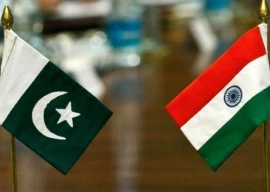
QUETTA:
Mohammad Ayub, 12, finds it difficult to understand what his teacher says. “I speak Balochi at home and find it difficult to understand Urdu,” he says.
Balochi is not taught in schools in Balochistan, while Persian has been included in the high school curriculum. Rasool Baksh Raisani, a professor at the education department of University of Balochistan, says it would have been better if Balochi was taught in Baloch-dominated areas and Pashto in the northern belt of the province. “We cannot deny the importance of the mother tongue as teachers can communicate better in their own language. But the problem is that enough research has not been done in Balochi and there is no literary material available,” he argues. “First we have to work on advancing the language.”
In his grubby dress, Mohammad appears more confident than his fellow students in grade four of a government primary school in Wahadat Colony, Quetta. He is the only one amongst six children who responds to questions, while others smile shyly.
He is not very confident of his dreams and aspirations, nor does he know why he needs an education. “I’ll be a doctor...no, no engineer,” he responded in Balochi, while looking at the floor.
There is an irking foul smell at the school because the building has no sewage system. A classroom located near the toilet had to be made a parking lot because it was impossible for students to study there.
The Wahadat Colony school has around 900 students with 21 classrooms, each accommodating 60 to 65 students. Students say there are 22 teachers, of whom 18 turn up for classes regularly. When teachers were asked about the low attendance, they did not give a clear answer.
Primary school subjects include Urdu, Math, Social Studies, Islamic Studies, Science and English. English was made a compulsory subject in public sector primary schools around two years ago.
Ghost schools
Countless schools in Balochistan only exist on record. One such primary school in Mullah Khail, situated in Nawah Killi, on the outskirts of Quetta, has turned into a garbage site and a playground for children.
Hafiz Mujeeb, an elderly man from Mullah Khail, said the school was established about 16 years ago, but was shut down within two years. “Three teachers were appointed at that time and they are still being paid by the government,” he said.
Nawah Killi has a population of 5,000 people and 500 to 600 students were deprived of education after the school closed down.
People who have enough finances to send their children to private schools do so, while an overwhelming majority enrols their children at religious seminaries.
Education budget
Balochistan Government has allocated Rs21.8 billion for the education sector in the current fiscal year, with Rs19 billion for non-development and Rs2.8billion for development expenditure. Despite the huge allocation, around 13% of the provincial budget, hundreds of ghost teachers and schools exist in the rural areas of the province.
According to government data, there are 10,611 primary schools across the province with a total enrolment of 541,519 students, of whom 215,488 are girls. There are 13,692 teachers in the province.
Most children, particularly girls, leave the school after completing their primary education. At the middle and high school level, the total enrolment is 265,016.
According to Balochistan Rural Support Programme, 60 to 62 per cent primary schools lack basic facilities like clean drinking water, toilets, a roof and sometimes even a boundary wall. “About 90 per cent girls in rural areas leave school after passing fifth grade,” says Muhammad Anwar Panezai, manager Social Sector and Relief Operations of BRSP.
Teachers’ appointments and literacy rate
A senior civil servant said most appointments for teachers were made on a political basis “The schools have been turned into guestrooms and teachers are working as security guards for politicians and tribal elders. Teachers are paid, but they do not attend classes since schools do not exist,” he said, while requesting anonymity. According to Balochistan Education Minister Tahir Mehmood, there are 5,000 such primary schools in the province.
“The government is paying special attention to education as it has upgraded more than 120 schools across the province, providing them with basic facilities.”
Professor Rasool Baksh Raisani said: “Teachers mostly suppress students to hide their own weaknesses, because of which students lack the courage to ask questions and come up with innovative ideas,” he said.
“Balochistan’s literacy rate is 35%, less than that in any other province and reforms are desperately needed,” he added.
According to Raisani, a scattered population and unemployment are other factors behind the low literacy rate. “The people in rural areas prefer to involve their children in agriculture instead of sending them to schools because most educated people are jobless.”
Published in The Express Tribune, October 10th, 2011.
COMMENTS (4)
Comments are moderated and generally will be posted if they are on-topic and not abusive.
For more information, please see our Comments FAQ





















































i a gree with this story whay should we learn ordo ,arabs farci english, we have own mather tongue,
Balochistan is being deprived in every sense. Sindh govt has approved mandatory learning of Chinese language in the province while no concern about the Balochi language in Balochistan. If not provincial govt at least federal should do something for betterment of Baloch people. Richest but poorest and less literate province.. Shame on the politicians
In India students study either in their mother-tongue or in English. Whereas in Pakistan there is an additional burden of learning Urdu which is hampering the learning process of students. The sooner Pakistan gets rid of this one-language nationalism, the better.